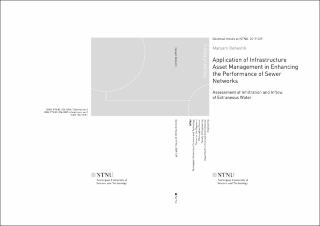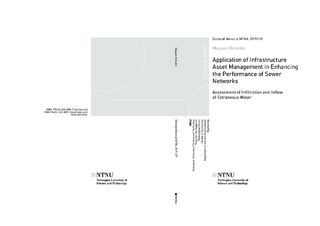| dc.contributor.advisor | Sægrov, Sveinung | |
| dc.contributor.advisor | Muthanna, Tone Merete | |
| dc.contributor.author | Beheshti, Maryam | |
| dc.date.accessioned | 2020-02-21T08:48:17Z | |
| dc.date.available | 2020-02-21T08:48:17Z | |
| dc.date.issued | 2019 | |
| dc.identifier.isbn | 978-82-326-3857-4 | |
| dc.identifier.issn | 1503-8181 | |
| dc.identifier.uri | http://hdl.handle.net/11250/2643143 | |
| dc.description.abstract | Wastewater transportation systems are one of the main city lifelines and initial prerequisites for urban areas all over the world. Sewer networks represent a high value in water infrastructure assets, and it is important to be preserved, developed and operated by sustainable sewer infrastructure asset management (IAM). Infiltration and inflow (I/I) of unwanted water from different sources—stormwater, groundwater, snowmelt or illicit and faulty connections—in urban sewer systems are significant challenges for sewer IAM and have negative impacts on environmental, public health and economic aspects of sustainable urban wastewater management as well as on chemical and energy resources. In many cities worldwide urban sewer networks are prone to a significant amount of unwanted water ingress from unknown sources due to aging and deterioration in the structure. Therefore, I/I assessment is a prerequisite to evaluate the sewer network performance and restrict unwanted water I/I, which should be considered in strategic long-term rehabilitation planning of sewer IAM.
The overall goal of the presented Ph.D. dissertation is to improve the efficiency and performance of urban sewer systems in the context of sewer IAM with a focus on assessment and detection of unwanted water I/I. Four objectives were defined along with three planning levels of sewer IAM—strategic, tactical and operational—, which are interconnected successively. The first objective was in line with the strategic level planning of “increasing resilience and performance of the sewer system”. It discussed the evaluation and improvement of the sewer system efficiency from I/I aspect by strategic maintenance, rehabilitation, and renewal planning in a long-term period. The second objective defined the requirement for investigating and classifying available I/I assessment and detection techniques and finding the most relevant and practical methods for I/I studies at the medium-term tactical level. The last two objectives were in the category of the operational level with a focus on the unwanted water I/I detection and assessment in the short term in order to increase the level of preparedness of the sewer system against I/I of unwanted water in the long term.
The first objective presented the results of a sustainability analysis on the wastewater transport system of Trondheim, Norway, for future planning (2014-2040) from a metabolism-based performance analysis by Dynamic Metabolism Model (DMM) and compared with ‘status quo’ with constant development of the wastewater network. This work aimed to demonstrate a methodology for comparing different pathways toward sustainable management of wastewater systems. Therefore, four intervention strategies ‘infiltration and inflow reduction’, ‘increasing rehabilitation rate’, ‘extension of the system regarding population growth’, ‘energy management’ along with different combinations of them were analyzed from environmental, functional and economic aspects.
At the tactical level, intervention priorities, methods, and solutions were defined to reduce the infiltration in critical zones by practical methods in the medium-term period. Therefore, the available commonly used and advanced methods of I/I detection and assessment were classified to quantitative and qualitative techniques and evaluated based on their advantages and limitations by a critical literature review. A combination of these techniques can provide the sewer operators the possibility to compare different technologies and select the relevant ones based on the selection criteria.
In addition to the data collection and analysis in the tactical planning level, I/I simulation by mathematical modeling is a good measure to assess the status of the infiltration and inflow in the sewer network. In the present study, the sewer network of Lykkjbekken catchment in Trondheim was modeled and assessed. The simulation of the sewer flow emphasized on the presence of high rainfall-induced infiltration and inflow during wet weather conditions, whereas the groundwater infiltration during dry weather conditions was insignificant.
The effective reduction of I/I requires information about the location and source of I/I. The third objective of this study focused on I/I detection in the foul sewer network of a catchment in Trondheim during a period without snowmelt or groundwater infiltration. Fiber-optic distributed temperature sensing (DTS) was used for the first time in Norway to detect I/I in tandem with closed-circuit television inspection (CCTV) and smoke testing. The DTS was an accurate and feasible method for I/I detection, though it cannot identify exact types of failure and sources of I/I. Therefore, other complementary methods were used, e.g., CCTV or smoke testing. However, the CCTV was not completely successful in confirming three I/I sources detected by the DTS. This part of the study provides practical insights for the rehabilitation and repair of sewer networks that suffer from the undesirable I/I of extraneous water.
The last objective aimed at accurate quantification of unwanted water I/I from individual sources into a sewer system to assess the status of the sewer network, prioritize problematic parts, and conduct rehabilitation measures. To quantify extraneous water I/I into a sanitary sewer network, the DTS method was applied. The feasibility of DTS method was tested in both experimental discharges and for the rainfall-derived I/I. The achieved results from the monitoring campaign established the promising applicability of the DTS technique in the quantification analysis. Furthermore, the application of this method in quantifying real-life, rainfall-derived I/I into the sewer system was demonstrated and verified during wet weather conditions. This part of the study fills the knowledge gap of availability of reliable and accurate I/I assessment data for having more efficient maintenance and rehabilitation plans. | |
| dc.language.iso | eng | nb_NO |
| dc.publisher | NTNU | nb_NO |
| dc.relation.ispartofseries | Doctoral theses at NTNU;2019:129 | |
| dc.relation.haspart | Paper 1:
Beheshti, Maryam; Sægrov, Sveinung.
Sustainability assessment in strategic management of wastewater transport system: a case study in Trondheim, Norway. Urban Water Journal 2018 ;Volum 15.(1) s. 1-8 https://doi.org/10.1080/1573062X.2017.1363253 | |
| dc.relation.haspart | Paper 2:
Beheshti, Maryam; Sægrov, Sveinung; Ugarelli, Rita.
Infiltration/Inflow Assessment and Detection in Urban Sewer System. Vann 2015 ;Volum 1.(1) s. 24-34 | |
| dc.relation.haspart | Paper 3:
Beheshti, Maryam; Sægrov, Sveinung.
Detection of extraneous water ingress into the sewer system using tandem methods – a case study in Trondheim city. Water Science and Technology 2019 ;Volum 79.(2) s. 231-239
https://doi.org/10.2166/wst.2019.057 | |
| dc.relation.haspart | Paper 4:
Beheshti, Maryam; Sægrov, Sveinung.
Quantification Assessment of Extraneous Water Infiltration and Inflow by Analysis of the Thermal Behavior of the Sewer Network. Water 2018 ;Volum 10.(8) Suppl. 1070 s. 1-17
https://doi.org/10.3390/w10081070
This is an open access article distributed under the Creative Commons Attribution License (CC BY 4.0) | |
| dc.title | Application of Infrastructure
Asset Management in Enhancing
the Performance of Sewer
Networks:
Assessment of Infiltration and Inflow
of Extraneous Water | nb_NO |
| dc.type | Doctoral thesis | nb_NO |
| dc.subject.nsi | VDP::Technology: 500::Environmental engineering: 610 | nb_NO |

